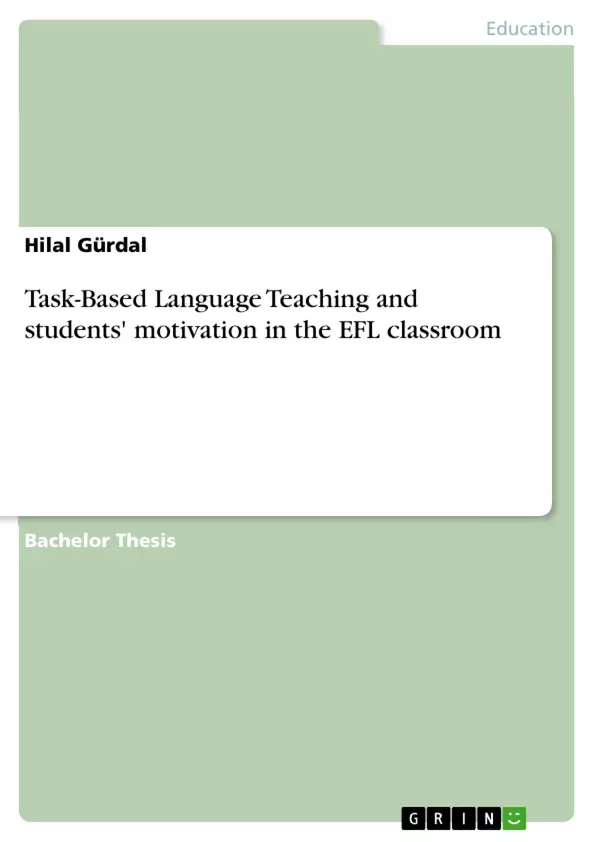This thesis aims to examine the intrinsically motivating aspects of task-based language teaching (TBLT) in the EFL classroom. It will be started with communicative language teaching (CLT) as a precursor to TBLT. The theoretical context will be discussed with particular reference to Stephen Krashens’ Affective Filter Hypothesis as it has influenced research on motivation in foreign language learning as well as TBLT. After that, the current paradigms of CLT will be presented, focusing on its changes compared to former language teaching methods.
Moreover, the terminology of motivation will be addressed by first providing a clear definition and then going on to discuss motivation in foreign language teaching. Although there are countless theories in this particular field, the most important theory for the course of this thesis is the Self-Determination Theory by Ryan and Deci as it first introduced the concepts of intrinsic and extrinsic motivation. Besides, the teacher and learner roles will be discussed to see how they affect each other’s motivation. Furthermore, Dörnyei’s motivational strategies for the foreign language classroom will be outlined to show how student motivation can be initiated and maintained.
The next chapter introduces the task-based language teaching approach thoroughly explaining the concept of a task in order to grasp its main ideas and differences compared to an exercise. Then the various task types and the role of teacher and learner will be explored to see how they operate in the EFL classroom. Thereafter, Jane Willis’ TBL framework will be presented by discussing the aim of each stage in detail.
Lastly, a sample lesson designed by Jane Willis will be presented to demonstrate the implementation of TBLT and to scrutinize its impact on student motivation. Therefore, the previously mentioned aspects of motivation will be taken up to examine how they are integrated in TBLT focusing especially on intrinsically motivating factors.
Inhaltsverzeichnis (Table of Contents)
- Introduction
- Modern communicative language teaching (CLT)
- Theoretical context
- Current Paradigms
- Motivation
- Definition
- Motivation in foreign language learning
- Self-Determination Theory: Intrinsic and extrinsic motivation
- Teacher and learner motivation
- Motivational strategies in the foreign language classroom
- Task-based language teaching (TBLT)
- Defining a task
- Task types
- Teacher and learner roles in TBLT
- The TBL framework by Jane Willis
- The impact of TBLT on student's motivation
- Conclusion
Zielsetzung und Themenschwerpunkte (Objectives and Key Themes)
This thesis investigates the motivational aspects of task-based language teaching (TBLT) in the EFL classroom. It analyzes the concept of communicative language teaching (CLT) as a precursor to TBLT, focusing on the theoretical context and current paradigms. Furthermore, it explores the definition and significance of motivation in foreign language learning, highlighting the Self-Determination Theory by Ryan and Deci. The research examines the interplay between teacher and learner motivation and outlines Dörnyei's motivational strategies. Finally, it delves into TBLT, exploring task types, teacher and learner roles, and Jane Willis' TBL framework, aiming to understand the impact of TBLT on student motivation.
- The role of communicative language teaching (CLT) in foreign language acquisition
- The importance of motivation in foreign language learning
- The Self-Determination Theory and its application in the EFL classroom
- The principles and application of task-based language teaching (TBLT)
- The impact of TBLT on student motivation
Zusammenfassung der Kapitel (Chapter Summaries)
The introductory chapter highlights the challenges of generating motivation in the EFL classroom and introduces the concept of Task-Based Language Teaching (TBLT) as a potential solution. It outlines the thesis' aim to examine the intrinsically motivating aspects of TBLT and provides a roadmap for the following chapters.
Chapter 2 discusses the emergence of communicative language teaching (CLT) as a reaction to traditional methods. It explores the theoretical context, particularly Stephen Krashen's Affective Filter Hypothesis, which emphasizes the role of motivation, self-confidence, and anxiety in language acquisition. The chapter also presents the current paradigms of CLT, highlighting the shift from teacher-centred to learner-centred instruction.
Chapter 3 delves into the concept of motivation, defining it and discussing its importance in foreign language learning. It focuses on the Self-Determination Theory by Ryan and Deci, which introduces intrinsic and extrinsic motivation. The chapter explores the interplay between teacher and learner motivation and presents Dörnyei's motivational strategies for the foreign language classroom.
Chapter 4 provides a thorough explanation of the task-based language teaching (TBLT) approach. It defines a task, distinguishes it from exercises, and explores various task types. The chapter examines the role of the teacher and learner in TBLT and presents Jane Willis' TBL framework, which outlines the steps involved in implementing TBLT.
Chapter 5 analyzes the impact of TBLT on student motivation. It examines how the intrinsically motivating factors discussed in previous chapters are integrated into TBLT, providing evidence for its effectiveness in enhancing student engagement and language acquisition.
Schlüsselwörter (Keywords)
This thesis focuses on the following keywords: communicative language teaching (CLT), task-based language teaching (TBLT), motivation, foreign language learning, intrinsic motivation, extrinsic motivation, Self-Determination Theory, teacher motivation, learner motivation, Affective Filter Hypothesis, comprehensible input, task types, TBL framework.
- Citation du texte
- Hilal Gürdal (Auteur), 2021, Task-Based Language Teaching and students' motivation in the EFL classroom, Munich, GRIN Verlag, https://www.grin.com/document/1030132



